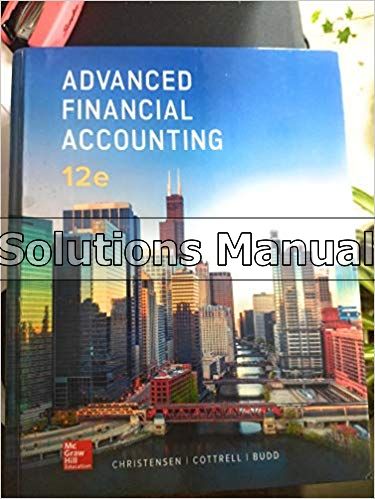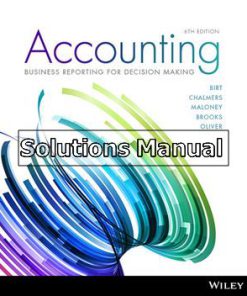Advanced Financial Accounting 12th Edition Christensen Solutions Manual
$26.50$50.00 (-47%)
Advanced Financial Accounting 12th Edition Christensen Solutions Manual.
You may also like
This is completed downloadable of Advanced Financial Accounting 12th Edition Christensen Solutions Manual

Product Details:
- ISBN-10 : 1259916979
- ISBN-13 : 978-1259916977
- Author;
The Twelfth Edition of Advanced Financial Accounting is an up-to-date, comprehensive, and highly illustrated four-color presentation of the accounting and reporting principles and procedures used in a variety of business entities. Every day, the business press carries stories about the complexities of modern business entities, and students must know how to deal with the accounting and reporting ramifications of issues such as:
- mergers and acquisitions
- new organizational structures
- accounting scandals related to complex transactions
- foreign activities of multinational firms
- operations of governmental and not-for-profit entities
- bankruptcies of major firms
- and more!
This edition continues to provide strong coverage of Advanced Accounting topics with clarity of presentation and integrated coverage based on continuous case examples. The text is complete with presentations of worksheets, schedules, and financial statements so students can see the development of each topic. Inclusion of recent FASB and GAAP pronouncements – and focus on the continuing deliberations of the authoritative bodies – provide the most current content for students preparing for the CPA examination and their future careers. Given the recent rapid pace of the authoritative bodies in dealing with major issues, the emphasis on currency and standards in Advanced Financial Accounting has become more important than ever for both students and aspiring professionals.
Table of Content:
Chapter 1:
Assignment of acquisition costs:
Memo:
To: Vice President of T Company
From: AAA, CPA
Re: Recording the cost of acquisition of Business Combinations:
On reviewing the accounting statements, it was reviewed that T Company acquired the ownership of K Company, by transferring the assets and liabilities.
According to the accounting standards the requirement of the acquisition is that all the direct costs involved in buying another organization will be stated as portion of the total cost which is acquired by the organization. The cost involved in issuing preferred and common stock in a business combination requires to be stated as reduction in the fair value of the securities.
In acquiring company K, company T paid an amount of $720,000. The purchase price of company K must include the finder’s fee of $200,000 and legal fees of $90,000 so as to transfer the assets and liabilities of company K to company T. The payment made amounting to $60,000 for registration of the stock and audit fees must be documented as reduction of the paid-up-capital documented when the shares of the T Company were issued to attain the shares of company K. The potential cost is the legal cost amounting to $370,000which resulted from the litigation by the shareholders of company K.
Out of the total cost incurred, the amount of $660,000 must be allotted to the purchase price of Company K and the amount of $60,000 is documented as a reduction of paid-in-capital.
The acquired corporations must be valued under FASB 141R at the consideration’s fair value given in exchange in addition to the fair value of the shares acquired by the acquire and the fair value of the non-controlling interest at the date of combination.
Chapter 2:
a)
When the investor has considerable influence over the organization, the equity method of reporting is used. When the investor holds more than 20% of the ownership, the situation is referred as considerable influence.
The following are the factors to determine the appropriateness of reporting in equity method:
• Investor having representation on the board of directors or the investor has to gain representation and not able to achieve it.
• To exercise the considerable influence, the organization has considered the complaints or litigations challenging the ability of the investor.
• Whether the organization is under the control of the courts or other supervising parties are entering into liquidation or filing for reorganization.
• If the investor is able to attain the information that is required for using the equity method.
• Whether the investor has signed an official document to represent his/her capability to exercise considerable influence.
b)
Methods which show larger reported contribution:
• When the subsidiary net income is more than the paid dividends; the first method in report the equity is probably to represent a greater recognized contribution to the earnings of SBS.
• When the earnings in 2014 are negative or less than the distributed dividends; the other is used where the cost basis is probably to give greater contribution to SBS.
c)
Equity method of reporting more appropriate with the increase of ownership percentage;
• The greater resources of an investor will be used to attain the ownership of the organization that implies that the investor will have more share of profit and losses in the investee as such the investor’s financial well-being is associated with the success of the investee.
• Right to take the decision will be achieved after the ownership of the investor, reaches at a good level.
• The possibility of the investor deploying its own benefits also decreases by using the equity method of reporting.
People Also Search:
advanced financial accounting christensen
advanced financial accounting 12th edition christensen
advanced financial accounting
advanced financial accounting 12th edition
advanced financial accounting 12th edition download scribd
advanced financial accounting 12th edition solution manual download pdf












